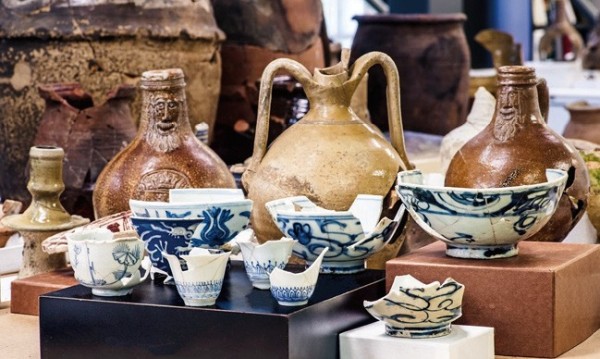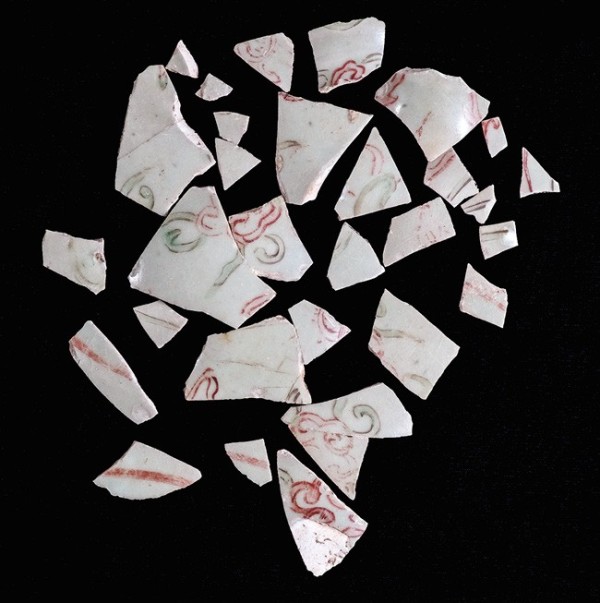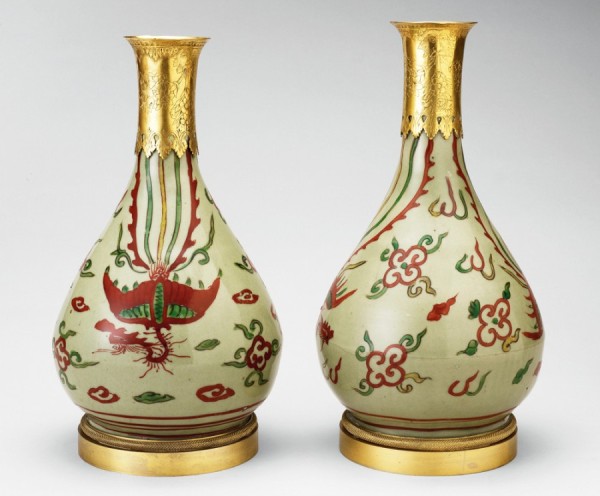
James Fort archaeological features and interpretations of structures superimposed on the modern-day landscape. (Courtesy, Jamestown Rediscovery Foundation; photo composition, Jamie May.)

A selection of the wide range of ceramics from England, Continental Europe, and China dating to 1600–1625 that have been recovered from James Fort. (Courtesy, Jamestown Rediscovery Foundation.)

Bottle fragments, Southern China, 1575–1625. Hard-paste porcelain. (Courtesy, Jamestown Rediscovery Foundation.)

Merry Outlaw and Ron Fuchs looking at fragments from the bottle. (Photo, Robert Hunter.)

Bottles, Southern China, 1575–1625. Hard-paste porcelain. H. 17 3/8". (Royal Collection Trust / © Her Majesty Queen Elizabeth II 2021.) The gilt bronze mounts were added in Europe in two phases, in 1675–1700 and 1800–1820.

Bottle fragments showing the tail feathers and neck of the fenghuang, Southern China, 1575–1625. Hard-paste porcelain. (Courtesy, Jamestown Rediscovery Foundation.)

Christian Richter (1678–1732), Portrait of Queen Mary II, after 1704. Watercolor on vellum. H. of portrait 2 1/2". (Private collection; photo, Robert Hunter.)

Isaac Oliver (1565–1617), Portrait of Robert Cecil, 1st Earl of Salisbury, ca. 1600. Tempera on vellum. H. of portrait 2". (© Burghley House Preservation Trust Limited.)
THERE IS A BIRD whose shape is like a cock. It has five colors and stripes. It is called feng-huang. [As the dragon is the chief of the animals, the phoenix is the chief of the birds. It is the symbol of happiness.] The stripes on the head are called virtue; the stripes on the wings, justice; on the back, politeness; those on the breast are called humanity; those on the stomach, honesty. This bird drinks and eats, sings and dances, by itself. When it appears the world enjoys peace.
—Shan Hai Ching (The Classic of Mountains and Rivers)[1]
In 1606 the joint-stock Virginia Company of London received a charter from King James I (r. 1603–1625) to establish a British foothold in North America, discover the Northwest Passage, and enrich its shareholders. The first three ships bound for Virginia left London in December 1606 and arrived in the Chesapeake Bay in April 1607. On May 14, 1607, the colonists settled at Jamestown, a low-lying peninsula in the James River about forty miles upriver from the Chesapeake Bay. Within a few weeks, they built James Fort, which served as the colony’s base of operations until Virginia became a royal colony in 1624 (fig. 1).[2]
Despite a continuing threat of collapse due to sickness, starvation, mismanagement, and warfare with Native Americans, Jamestown endured, becoming the first permanent English settlement in the New World. After Virginia became a royal colony, however, James Fort and its impermanent buildings disappeared. By the mid-nineteenth century many believed that the fort had eroded into the James River, but in 1994 archaeologists discovered most of the fort on dry land, and excavations have continued ever since.
Excavations of the fort have uncovered nearly three million artifacts dating to the first quarter of the seventeenth century (fig. 2). Numerous personal possessions attest to the wealth and status of the gentlemen soldiers who occupied James Fort. A large assemblage of prestige items includes almost two thousand Chinese porcelain fragments from objects made in the late sixteenth and early seventeenth centuries during the Ming dynasty (1368–1644). These expensive wares not only reveal the wealth, privilege, and status of many settlers at Jamestown, but also illustrate the extensive global connectivity of maritime and merchant networks of the period.[3]
Jamestown’s Chinese porcelain assemblage primarily contains objects made in private workshops in Jingdezhen, Jiangxi province, for export to Southeast Asia and Europe. But porcelain objects made at other kilns in the southern coastal provinces of Guangdong and Fujian have also been found at Jamestown. Among them is a bottle with red and green motifs painted in overglaze enamels on a celadon green ground that is represented by thirty-
one fragments (fig. 3). The fragments were recovered from a disturbed context in Fort Pocahontas, a fortification built by Confederate troops in 1861 that overlaid the seventeenth-century James Fort.
At the time of the discovery of the bottle fragments, clouds were the only identifiable motif. Ron Fuchs, senior curator of ceramics at Washington and Lee University in Lexington, Virginia, located in the British royal collection a pair of bottles dated to the late sixteenth or early seventeenth century that are comparable to the Jamestown example (figs. 4, 5).[4] The pear-shaped bottles are decorated on opposite sides with a descending bird among flames and clouds over a light-green celadon glaze.5 Five elongated polychrome tail feathers descend from the bottle neck to join a body with spread red wings. The bird’s snakelike neck is fringed with down. Previously unrecognized on the Jamestown fragments, the outer tail feathers of the opposing birds and the fringed bird neck are now identifiable (fig. 6).
Known from ancient Chinese mythology as fenghuang, the bird comprises several animals and represents “uprightness, humanity, virtue, honesty, and sincerity.”[6] Purportedly, the first emperor who saw a fenghuang was the legendary Huangdi, who ruled in the twenty-seventh century bce; the last was Hongwu, founder of the Ming dynasty.[7] For centuries in Chinese lore, feng, the male bird, signified the emperor, and huang, the female bird, symbolized the empress. Eventually, the bird represented only the empress, while the imperial five-clawed dragon denoted the emperor.[8] Since pairs appear on the extant bottles, however, the two fenghuang perhaps symbolize the emperor and empress.
The bottles have been in the royal collection since at least 1829, when they were listed in the “Yellow Bow Room South of George IV’s Royal Pavilion Inventory” as “A pair of drab ground China Bottles with Imperial Birds & Scrolls, enamelled in green & red, mounted in ormolu engraved necks & circular bead bases.”[9] The palatial seaside residence in Brighton on the Sussex coast housed most of King George IV’s extensive Chinese and European porcelain collections until 1846, when Queen Victoria announced plans to sell the property and began to move the furnishings, including the fenghuang bottles, to Buckingham Palace, where they remain today.[10]
By the time the bottles were recorded in 1829, they were already two centuries old. Could these ancient and unusual fenghuang bottles have belonged to an even earlier English royal? Perhaps they belonged to Queen Mary II (r. 1689–1694), an avid collector of porcelain (fig. 7). Daniel Dafoe described her “vast stock of fine China-Ware” at Hampton Court Palace as “the like whereof was not then to be seen in England; the long gallery, as above, was fill’d with this china, and every other place where it could be plac’d, with advantage.”[11] She had some 787 pieces in her private apartments at Kensington Palace, among which were “two ollive [sic] coloured flasks” displayed “on the corner shelves next ye gardin” in the garden room in 1697.[12]
Of course, the bottles might have arrived in England shortly after they were made. Chinese porcelain was available in England in the sixteenth century and the first decades of the seventeenth, but only in small amounts and during that period tended to belong just to royalty, the aristocracy, and those with connections to global trade. Some well-connected individuals were able to amass collections of Chinese porcelain, such as Robert Cecil, 1st Earl of Salisbury, a notable investor in the East India Company (fig. 8), whose collection was described in 1602 by his agent, William Stallenge, as “the fayrest China Dishes of all sorts that ever were seen.”[13] Later, in 1609, Cecil opened the New Exchange, a marketplace in London’s Strand, to stimulate the worldwide trade in which he had heavily invested and to encourage elite English consumers to purchase exotic trade goods, including Chinese porcelain.[14]
Many of the individuals with connections to Asia and the East India Company also had connections with the Virginia Company, suggesting a possible way that an exotic object like this Chinese porcelain bottle could have made it to Jamestown.[15] Among the people with connections to both Asia and Virginia was Robert Cecil, who also invested in the Virginia Company and was the patron of the Jamestown’s Deputy Governor, Sir Thomas Dale.[16] Upon arriving at the frontier outpost in 1611, Dale strictly enforced martial law and was responsible for the colony’s survival from 1611 until his departure in 1616. Dale reported that upon leaving Jamestown he “left the colony in great prosperity and peace contrary to many men’s expectations.”[17] Perhaps he left exotic porcelain purchases or gifts from his sponsor as well.[18]
ACKNOWLEGMENT I am indebted to Ron Fuchs, Senior Curator of Ceramics at Washington and Lee University in Lexington, Virginia, for his invaluable assistance in identifying Chinese porcelain in the archaeological collections of the Jamestown Rediscovery Foundation.
Shan Hai Ching (Mountain and Seas Classic), compiled between the fourth and first centuries b.c.e., is a mythological geography and natural history of China. Alan Priest, “Phoenix in Fact and Fancy,” Metropolitan Museum of Art Bulletin, no. 1, 2 (1942): 100.
For more information on the settlement at Jamestown, Virginia, see William M. Kelso, Jamestown, the Truth Revealed (Charlottesville: University of Virginia Press, 2017), which summarizes the history and archaeological excavations of James Fort until 2017.
In an article about a Ming porcelain dish discovered at Jamestown, Ron Fuchs discusses the many ways Chinese porcelain may have arrived at Jamestown in the New World. Ronald W. Fuchs II, “One of the Earliest Pieces of Chinese Porcelain in Virginia,” Ceramics in America, edited by Robert Hunter (Hanover, N.H.: University Press of New England for the Chipstone Foundation, 2019), pp. 49–57.
John Ayers, Chinese and Japanese Works of Art in the Collection of Her Majesty the Queen, 3 vols. (London: Royal Collections Trust, 2016), 1:87.
Ibid.
Generally called a “phoenix” by Europeans, the mythological fenghuang is a bird with different origins, appearance, and cultural significance. Because Chinese scholars prefer it, I use fenghuang in this text. Lyujie Zhu, “Fenghuang and Phoenix: Translation of Culture,” International Journal of Languages, Literature and Linguistics 6, no. 3 (2020): 122–28.
Encyclopedia Britannica Online, s.v. “Fenghuang,” https://www.britannica.com/topic
/fenghuang.
Priest, “Phoenix in Fact and Fancy,” p. 100.
Ibid.
https://historicengland.org.uk/listing/the-list/list-entry/1380680.
Susan Broomhall and Jacqueline Van Gent, Dynastic Colonialism: Gender, Materiality and the Early Modern House of Orange-Nassau (London: Routledge/Taylor & Francis Group, 2016), p. 255.
Arthur Lane, “Queen Mary II’s Porcelain Collection at Hampton Court,” Transactions of the Oriental Ceramic Society, 1949–1950 (1952): 28; “Inventory of Porcelain at Kensington Palace, 1697,” quoted in Mark Hinton and Oliver Impey, eds., Kensington Palace and the Porcelain of Queen Mary II (London: Christie’s in collaboration with the Ashmolean Museum, Oxford and Historic Royal Palaces, 1998), pp. 43–45.
Oliver Gerlach, “Kraak ware: Curiosity, Exoticism and the Social Life of Porcelain,” Bowdoin Journal of Art 7 (2021): 13.
Evelyn Kathleen Welch, “The Senses in the Marketplace: Sensory Knowledge in a Material World,” in A Cultural History of the Senses in the Renaissance, edited by Herman Roodenburg (London: Bloomsbury Academic, 2014), p. 61.
Bly Straube, “Jamestown, Virginia: Virginia Company Period,” in Ceramics in America, edited by Robert Hunter and Angelika R. Kuettner (Hanover, N.H.: University Press of New England for the Chipstone Foundation, 2017), pp. 198–99; Fuchs, “One of the Earliest Pieces of Chinese Porcelain in Virginia,” pp. 49–57.
While serving in the military of the States General of the Netherlands, Dale was released from his duties to go to Jamestown to serve as Deputy Governor. Dale’s patron, Sir Robert Cecil, helped secure his release. Perhaps the Dutch released Dale in anticipation of markets opening to them in the New World. Although absent from Dutch service for several years, Dale received compensation for pay while in Virginia. Darrett B. Rutman, “The Historian and the Marshal: A Note on the Background of Sir Thomas Dale,” Virginia Magazine of History and Biography 68, no. 3 (1960): 284–94.
As quoted by James Horn in his 1619: Jamestown and the Forging of American Democracy (New York: Basic Books, 2018), p. 41.
After leaving Virginia, Dale served as commander of a British fleet for the East India Company. As noted by Bly Straube in her article “Jingdezhen, China . . . Bantam, Java . . . Jamestown, Virginia: Degrees of Separation for a Porcelain Bowl” in this journal, Dale sent a parcel of porcelain to his brother-in-law from the Far East, which demonstrates his interest in the ware.
